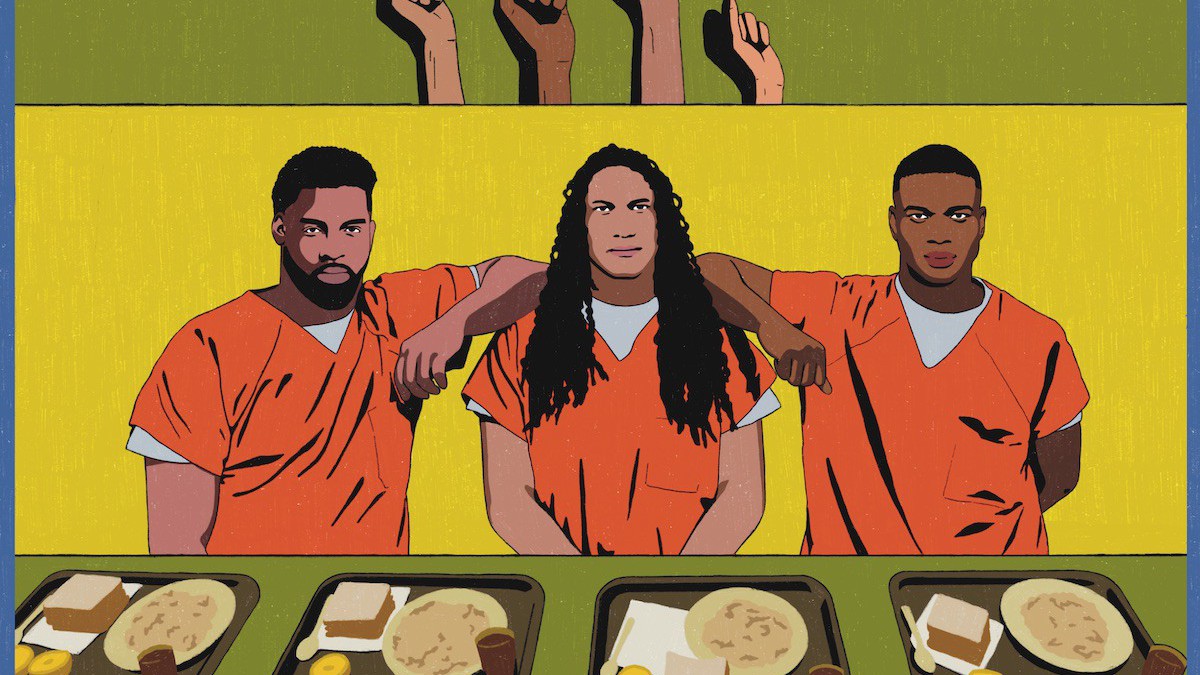When the pandemic hit Canada in March 2020, the situation in prisons felt particularly urgent: hundreds – in some places, thousands – of prisoners were trapped in poorly ventilated buildings together, with guards moving from cell to cell, often denying prisoners personal protective equipment and cleaning supplies. Organizers asked: could the government be forced to release people from prison to slow the spread of the looming virus? As supporters on the outside sprang into action, calling on the government to #FreeThemAll, prisoners faced up to the reality of 24-hour lockdowns, no more family visits, an already failing health-care system, and terrible food. The hunger strikes started not long after.
There are different kinds of hunger strikes in prison. As Gene, who asked that we use only his first name and who spent over 30 years in the federal prison system, explains, there are both individual and collective hunger strikes, some of them spontaneous and others carefully planned. “Individual hunger strikes very rarely worked at all,” he tells me. “The group [strike] is the one that might have a better chance of getting something done.” Spontaneous hunger strikes might happen as a result of a particularly brutal incident. “Let’s say the guards come in to take a guy out to the hole [solitary confinement] because he told a guard to fuck off […] and they come in there and they beat the guy senseless. Like he’s right out and there’s blood everywhere and they drag him off. People are going to freak out and you could have a hunger strike.” Planned hunger strikes, on the other hand, might be a response to a deteriorating situation in the prison, like lack of medical care.
“Individual hunger strikes very rarely worked at all,” he tells me. “The group [strike] is the one that might have a better chance of getting something done.”
Regardless of the timing and planning, Gene emphasizes the importance of having a good reason for the strike and explaining it clearly to other prisoners. “If it’s a legit goal and you actually explain it, then people can agree with it,” Gene says. The most successful hunger strikes, in his experience, have been those organized by the prisoners’ committee – in federal prisons, a group of prisoners elected to represent their peers to the administration – or a well-respected group of prisoners who have some amount of power within the prison. These successful hunger strikes also involved the highest rates of participation.
Even if prisoners are very well organized and there are high levels of participation, there is always another element a hunger strike needs to succeed: outside support. As Gene elaborates, “The whole idea is to try and get people outside to care because it doesn’t matter what you’re doing inside if the news never gets outside. What’s the old saying? If a tree falls in the forest, does anybody hear it?”
Gene can’t remember many details about the hunger strikes he’s participated in, save for a strike that lasted two weeks in a Special Handling Unit – long-term solitary confinement – decades ago. A group of prisoners who were all being held in the same wing of the SHU went on hunger strike together. He doesn’t think they won much. In order to test his impressions, I spoke to Mike Gouldhawke, a Métis and Cree organizer who’s written about historic hunger strikes by Indigenous prisoners. Gouldhawke also compiled a list of articles and resources covering the hunger strikes in Saskatchewan prisons from December 2020 to February 2021.
According to Gouldhawke, there are at least two more types of hunger strikes to add to the list. Indigenous prisoners who participated in the famous 1983 Kent hunger strike, which was about access to significant spiritual items, thought of their strike as a spiritual hunger strike. Gouldhawke explains, “Maybe when non-Native prisoners do a hunger strike, they’re not thinking of it as a spiritual thing. They’re thinking of it as just a tactic to meet a certain goal. But I think for Indigenous prisoners, there’s the spiritual aspect, because we would have fasting in our culture already, before prisons ever were brought to this territory. So in a way, it’s partly the connection of that or the spirituality just inherent in doing the hunger strike.”
“The whole idea is to try and get people outside to care because it doesn’t matter what you’re doing inside if the news never gets outside. What’s the old saying? If a tree falls in the forest, does anybody hear it?”
In addition to undertaking spiritual hunger strikes, Indigenous prisoners also fasted in solidarity with the communities of Kanesatake and Kahnawà:ke during the so-called “Oka Crisis.” In fact, Gouldhawke draws similarities between the era of the Kanesatake resistance in 1990 and the Red Power movements of the ’60s and ’70s that led to the hunger strike in Kent in 1983. Both periods were times of “cultural revival for all Native people across the continent,” he says, sparking action inside and outside of prisons – actions that built on each other toward broader, movement-level goals. As Indigenous prisoners supported movements on the outside, they could also count on support from the outside for actions they initiated.
This was definitely true for the 1983 Kent hunger strikers. As they wrote in a collectively published pamphlet describing their strategy of hunger striking while pushing their case through the court system, “We are of the opinion that any further negotiations with the Kent prison administration is useless. We have no other alternative but to seek remedy to this religious persecution in the Courts of our Oppressors, fully realizing that the courts protect and enhance the corporate states over the rights of the People. We also realize that if enough People become interested and involved in a struggle that concerns the rights of ALL the people, then the courts will be a little more careful to protect their supposed image of impartiality.” Their spiritual hunger strike drew support from a number of outside organizations, with sympathetic articles being written in the media and outside organizers sending letters to politicians and organizing benefit concerts. Gouldhawke says this outside support played a role in the strikers’ success, and even if their demands weren’t met right away, the hunger strikers contributed to a movement that eventually forced the government of Canada to recognize Indigenous prisoners’ rights to practise their spirituality in prison, at least in the federal system.
This past year – from March 2020 to March 2021 – has seen more than 21 hunger strikes in Canadian prisons. All but four happened in provincial jails, where people are imprisoned while awaiting trial or for sentences less than two years long. Two were individual strikes, while the rest were collective. By a very conservative estimate, at least 700 prisoners have participated in at least one strike, with six provincial prisons seeing more than one. Demands have centred around more yard time, better food, and access to cleaning supplies and personal protective equipment. Prison officials have mostly responded by meeting the smallest demands and ignoring the rest.
The hunger strike in March 2021 at Barton jail in Hamilton, Ontario, is an example of this dynamic. “The list of demands that we got came from the unit next to us. They’re the ones primarily organizing the hunger strike because they’re fed up with the lockdowns within this past month or so,” says Noah, who was incarcerated at Barton and asked that his last name not be used. Noah and I spoke in mid-March, as the hunger strike was winding down; it was the second at Barton in a 12-month period. This time, they were demanding access to cleaning supplies; clean bedding; regular yard time; and the restoration of visits, calls with lawyers, and programs. Compared to their first strike, which achieved some minor victories, this one yielded few gains for prisoners.
Noah partly attributed the failure of this hunger strike to its short duration. “I felt that if we were well prepared we could have gone for much longer, which would in turn [have] prompted a response that would be satisfying. The changes that happened were that we managed to get some items on canteen, including noodles. We were advocating for better hygiene products; that didn’t happen. And more yard time; we did get that, but not as much as we thought we would get. Everything else was pretty much forgotten about.”
“It seems the administration is fairly responsive to bad public pressure and publicity,” Dumont notes. But she says that response often looks like “offer[ing] whatever it is off the demand list that is easy to give the prisoners, both to stop the hunger strikes from continuing and to save a bit of face in the press.”
There were similar outcomes at the Ottawa-Carleton Detention Centre (OCDC). According to Souheil Benslimane, an organizer with the Criminalization and Punishment Education Project (CPEP) in Ottawa, their first hunger strike in June 2020 resulted in the administration agreeing to give some prisoners peanut butter packets with their meal trays. The prisoners’ wide-ranging and specific demands around food were mostly ignored, as were their demands relating to increasing access to family by reducing restrictions on photos and implementing an interim video visitation process.
Moira Dumont is an organizer with the Barton Prisoner Solidarity Project in Hamilton. The group set up a phone line at the start of the pandemic and has received numerous calls from Barton jail. The group has supported two rounds of hunger strikes in the prison, including pushing sympathetic journalists to report on the action, flyering outside the prison to raise awareness, and using social media to spread word of the prisoners’ demands. “It seems the administration is fairly responsive to bad public pressure and publicity,” Dumont notes. But she says that response often looks like “offer[ing] whatever it is off the demand list that is easy to give the prisoners, both to stop the hunger strikes from continuing and to save a bit of face in the press.”
The most successful hunger strike of the year was the very first one, which happened at the Laval migrant prison in late March 2020. The detainees demanded their own release from the detention centre, and within two months, most of the hunger strikers had been released. This outcome is surprising, given how few other hunger strikes won their demands. In an attempt to figure out the key to their success, I spoke with one of the participants, Oladipo Smith.
According to Smith, most of the first wave of Laval hunger strikers were being held for “identification purposes,” which meant that the state had “alternatives to detention.” In these cases, policy stated that detention was supposed to be a last resort. The Canada Border Services Agency has ways to monitor people outside of prison “through bracelets, through phone conferences, through halfway houses. So there are these other options for you to be able to release these individuals,” Smith explains. He tells me that the hunger strike forced the judges who were reviewing the detention of the migrant prisoners to do a more thorough review and to find alternative options to detention. This led to many migrant prisoners being released on bond.
The administration’s response to the second hunger strike was “to say, ‘Any demands that you guys put through on hunger strike, we’re not gonna meet them.’ It’s like a policy now.”
Smith attributes their success to the pandemic. That hunger strike happened during the first lockdown in Quebec, and as a result, he recalls, “People were idle and paid more attention to little things like immigration issues, so there was a lot more push from the outside.” He also points to the international reach of the social media campaign conducted by Solidarity Across Borders on the hunger strikers’ behalf. “Because of that, it probably got into the air of a lot more people who were making decisions, which is one of the reasons why the hunger strike was successful.”
But the second hunger strike at the Laval migrant prison in late February 2021 was less successful. In fact, Smith tells me that at least one hunger striker was deported. “Maybe because the administration saw the way that the first one went, so the consensus was that ‘we need to nip this idea in the bud. We are gonna make scapegoats of the second batch,’” Smith speculates. This isn’t a dynamic specific to the Laval migrant prison.
Benslimane recounts a similar dynamic in the provincial prison system. He says that at OCDC, the administration’s response to the second hunger strike was “to say, ‘Any demands that you guys put through on hunger strike, we’re not gonna meet them.’ It’s like a policy now.”
Pushing for change in the prison system is an uphill battle. What happens inside prisons is hidden from the public eye and, at the end of the day, many on the outside don’t care what happens to prisoners. Gene tells me, “One thing about the whole prison that people have to understand is [the administration] will never give in. Even if it’s the most common-sense thing, they won’t do it in some cases because they don’t want it to look like the prisoners had any power to change anything […] They want to make sure that [the message is] ‘You don’t tell us what to do. We tell you what to do.’” So hunger strikers must be prepared for a long fight.
“It’s like a big concrete pillar and you got a little hammer to chip away at it.”
Even if prisoners win small demands, Gene recommends continuing to fight. “You can’t give up because if you gave up after months of doing that if nothing much changed, then [...] it’s going to go backwards. Actually, it’s going to be really bad for you because now [the administration] knows that they can outlast you and then you’re screwed. That’s where you’ve got to be strong enough to stay together as a group.” It can be discouraging to know about this dynamic, in which prisoners push for change, galvanize each other with small wins, only to be faced with tougher circumstances later. As Gene frames it, “It’s like a big concrete pillar and you got a little hammer to chip away at it.”
Cory Cardinal, an Indigenous man who was, until recently, incarcerated in Saskatoon Provincial Correctional Centre (SPCC), was optimistic when we talked. Between November 2020 and January 2021, Cardinal galvanized his fellow prisoners into two rounds of hunger strikes. The first one started when he declared an individual hunger strike after sending letters to the justice minister about conditions facing prisoners in SPCC, to no response. His declaration led to others starting a hunger strike. “It was kind of like a grass fire, that one,” he recalled. His second hunger strike was collective, and while little was won from the administration, Cardinal focused on the feeling of unity that it fostered between the prisoners.
“What happened here was nothing short of a movement that came from a cell,” he told me. “It came from the depths of the prison. The corrections ministry, they were trying to muffle it, bury it, edit it, but they can’t muffle that message of humanity that sprouted from the depths of the prisons like a root that blossomed into a tree.”
Cardinal died of a suspected overdose in early June, a tragic loss to Saskatchewan’s prisoner justice movement.
August 10 is recognized by many prisoners and their supporters as Prisoners’ Justice Day. It was started in the mid-1970s by prisoners in Millhaven penitentiary in Bath, Ontario, after two long-time prison organizers, Edward Nalon and Robert Landers, died in solitary confinement. On Prisoners’ Justice Day, many incarcerated people refuse to eat and refuse to work in commemoration of other prisoners who have died inside.
This one-day hunger and labour strike isn’t as well-known or widely observed as it used to be. However, the legacy of Prisoners’ Justice Day has continued in this last year of COVID-era hunger strikes. As Gouldhawke tells me, “It’s not always clear how to distinguish one aspect of the struggle from another, because they all can create pressure that can lead to a public inquiry or policy change from the prison administration or the government. Things are all building on each other.” Though the hunger strikes of the last year have happened mostly in provincial prisons, they carry on the legacy of decades of struggle in federal prisons, which itself is connected to many different movements – from migrant justice to Indigenous sovereignty – outside prison.
Prisoners’ demands have held steady: decent food, contact with their loved ones, safety, dignity, and freedom. At the early June hunger strike in OCDC, Indigenous prisoners demanded access to spiritual and cultural practices, much like the Kent hunger strikers did in 1983. Their willingness to carry on the struggle inside is a sign for those of us on the outside that we, too, need to carry on.
“It’s not always clear how to distinguish one aspect of the struggle from another, because they all can create pressure that can lead to a public inquiry or policy change from the prison administration or the government. Things are all building on each other.”
“We need to do inter-movement work,” says Benslimane, encouraging prison abolitionists to team up with anti-colonial, Indigenous, and workers’ rights organizers. “I feel like when we are able to link all our struggles a little bit better, then prisoners are going to have a way better chance. But that’s yet to be seen,” he adds.
He points to a need for coordinated direct action by outside supporters. “It would take real sacrifices on the outside” to force change, he says. Here’s to it happening.







